Investigators analysing the fatal loss of an EgyptAir Airbus A320 are recommending a review of cockpit firefighting procedures – particularly regarding oxygen-fuelled fires – and believe greater research is needed on alternative extinguishing agents to halon.
The Egyptian air accident investigation commission’s recommendations draw on analysis by French counterpart BEA into attempts by the A320’s crew to combat a fire which, BEA believes, began in the first officer’s oxygen-mask storage box.
“Existing firefighting procedures have not been designed to deal with the specific case of an oxygen fire,” says BEA.
It says tests conducted in the aftermath of the 19 May 2016 accident “show that these procedures are ineffective and even counter-productive” in such circumstances.
Although the A320’s captain called for an extinguisher just 5s after the outbreak of fire, the investigation has been unable to determine whether an extinguisher was used.
The cockpit was equipped with a single halon extinguisher, and the cabin with three more - one located near the forward left-hand exit and two at the aft lavatory. There is “no indication”, says the inquiry, that any of the cabin extinguishers were used in the cockpit.
BEA says its tests showed that halon extinguishers were “not effective” at putting out a fire fed by a continuous oxygen leak.
While halon combines with oxygen, reducing the oxygen’s ability to fuel combustion, an oxygen leak will provide a constant fresh supply.
Under test conditions, BEA adds, using the extinguisher on the oxygen-enriched fire generated rapidly-spreading opaque smoke that reduced visibility.

Halon extinguishers are “not suitable” for treating an oxygen-fuelled blaze, it says, but these are often the only type available in the cockpit.
BEA highlighted four occurrences – all on the ground – involving cockpit fires, including one which badly damaged another EgyptAir aircraft, a Boeing 777-200ER, in Cairo. The captain attempted to use a halon extinguisher to control the fire but was unsuccessful.
The crew of a Corendon Airlines 737-800 similarly tried using a halon extinguisher on an oxygen fire at Antalya in 2012 but failed to control the blaze.
Fighting an oxygen-fuelled fire requires recognising its characteristics – BEA says such fires are intense and identifiable from a characteristic “blowtorch” noise – and cutting off the oxygen supply immediately to increase the effectiveness of extinguishing measures.
Both the Egyptian commission and BEA have recommended an assessment of cockpit fire procedures and, if necessary, a review of requirements to install and carry protective equipment. They also highlight a need to research other types of extinguisher, other than halon devices, which would prove suitable to attack oxygen-fuelled fires.


























